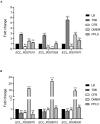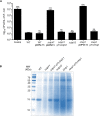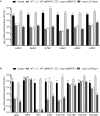Two Type VI Secretion Systems of Enterobacter cloacae Are Required for Bacterial Competition, Cell Adherence, and Intestinal Colonization
- PMID: 33072020
- PMCID: PMC7541819
- DOI: 10.3389/fmicb.2020.560488
Two Type VI Secretion Systems of Enterobacter cloacae Are Required for Bacterial Competition, Cell Adherence, and Intestinal Colonization
Abstract
Enterobacter cloacae has emerged as an opportunistic pathogen in healthcare-associated infections. Analysis of the genomic sequences of several E. cloacae strains revealed the presence of genes that code for expression of at least one type VI secretion system (T6SS). Here, we report that E. cloacae strain ATCC 13047 codes for two functional T6SS named T6SS-1 and T6SS-2. T6SS-1 and T6SS-2 were preferentially expressed in tryptic soy broth and tissue culture medium (DMEM), respectively. Mutants in T6SS-1-associated genes clpV1 and hcp1 significantly affected their ability of inter- and intra-bacterial killing indicating that T6SS-1 is required for bacterial competition. In addition, the Hcp effector protein was detected in supernatants of E. cloacae cultures and a functional T6SS-1 was required for the secretion of this protein. A clpV2 mutant was impaired in both biofilm formation and adherence to epithelial cells, supporting the notion that these phenotypes are T6SS-2 dependent. In vivo data strongly suggest that both T6SSs are required for intestinal colonization because single and double mutants in clpV1 and clpV2 genes were defective in gut colonization in mice. We conclude that the two T6SSs are involved in the pathogenesis scheme of E. cloacae with specialized functions in the interaction with other bacteria and with host cells.
Keywords: ClpV; E. cloacae; Hcp; T6SS; virulence.
Copyright © 2020 Soria-Bustos, Ares, Gómez-Aldapa, González-y-Merchand, Girón and De la Cruz.
Figures







Similar articles
-
The nucleoid protein HU positively regulates the expression of type VI secretion systems in Enterobacter cloacae.mSphere. 2024 May 29;9(5):e0006024. doi: 10.1128/msphere.00060-24. Epub 2024 Apr 22. mSphere. 2024. PMID: 38647313 Free PMC article.
-
Characterizing the type 6 secretion system (T6SS) of E. cloacae SBP-8 and its role in pathogenesis and bacterial competition.Microb Pathog. 2023 Oct;183:106268. doi: 10.1016/j.micpath.2023.106268. Epub 2023 Aug 1. Microb Pathog. 2023. PMID: 37536636
-
Hcp of the Type VI Secretion System (T6SS) in Acidovorax citrulli Group II Strain Aac5 Has a Dual Role as a Core Structural Protein and an Effector Protein in Colonization, Growth Ability, Competition, Biofilm Formation, and Ferric Iron Absorption.Int J Mol Sci. 2022 Aug 25;23(17):9632. doi: 10.3390/ijms23179632. Int J Mol Sci. 2022. PMID: 36077040 Free PMC article.
-
Confirmed and Potential Roles of Bacterial T6SSs in the Intestinal Ecosystem.Front Microbiol. 2019 Jun 28;10:1484. doi: 10.3389/fmicb.2019.01484. eCollection 2019. Front Microbiol. 2019. PMID: 31316495 Free PMC article. Review.
-
The T6SSs of Pseudomonas aeruginosa Strain PAO1 and Their Effectors: Beyond Bacterial-Cell Targeting.Front Cell Infect Microbiol. 2016 Jun 9;6:61. doi: 10.3389/fcimb.2016.00061. eCollection 2016. Front Cell Infect Microbiol. 2016. PMID: 27376031 Free PMC article. Review.
Cited by
-
Modulation of Quorum Sensing and Biofilms in Less Investigated Gram-Negative ESKAPE Pathogens.Front Microbiol. 2021 Jul 29;12:676510. doi: 10.3389/fmicb.2021.676510. eCollection 2021. Front Microbiol. 2021. PMID: 34394026 Free PMC article. Review.
-
Salmonella enterica serovar Typhimurium uses T6SS to promote bacterial adaptability and enhance its survival of niches in broiler chickens.Poult Sci. 2025 Aug;104(8):105277. doi: 10.1016/j.psj.2025.105277. Epub 2025 May 8. Poult Sci. 2025. PMID: 40412062 Free PMC article.
-
TssL2 of T6SS2 is required for mobility, biofilm formation, wrinkly phenotype formation, and virulence of Vibrio parahaemolyticus SH112.Appl Microbiol Biotechnol. 2024 Dec 17;108(1):537. doi: 10.1007/s00253-024-13351-8. Appl Microbiol Biotechnol. 2024. PMID: 39688690 Free PMC article.
-
cAMP Receptor Protein Positively Regulates the Expression of Genes Involved in the Biosynthesis of Klebsiella oxytoca Tilivalline Cytotoxin.Front Microbiol. 2021 Sep 30;12:743594. doi: 10.3389/fmicb.2021.743594. eCollection 2021. Front Microbiol. 2021. PMID: 34659176 Free PMC article.
-
The Role of ClpV in the Physiology and Pathogenicity of Xanthomonas citri subsp. citri Strain zlm1908.Microorganisms. 2024 Dec 9;12(12):2536. doi: 10.3390/microorganisms12122536. Microorganisms. 2024. PMID: 39770739 Free PMC article.
References
-
- Ares M. A., Abundes-Gallegos J., Rodriguez-Valverde D., Panunzi L. G., Jimenez-Galicia C., Jarillo-Quijada M. D., et al. (2019). The Coli Surface Antigen CS3 of Enterotoxigenic Escherichia coli is differentially regulated by H-NS, CRP, and CpxRA Global Regulators. Front. Microbiol. 10:1685. 10.3389/fmicb.2019.01685 - DOI - PMC - PubMed
-
- Ares M. A., Fernandez-Vazquez J. L., Rosales-Reyes R., Jarillo-Quijada M. D., Von Bargen K., Torres J., et al. (2016). H-NS Nucleoid Protein controls virulence features of Klebsiella pneumoniae by regulating the expression of type 3 Pili and the capsule polysaccharide. Front. Cell. Infect. Microbiol. 6:13. 10.3389/fcimb.2016.00013 - DOI - PMC - PubMed
LinkOut - more resources
Full Text Sources
Molecular Biology Databases
Miscellaneous

